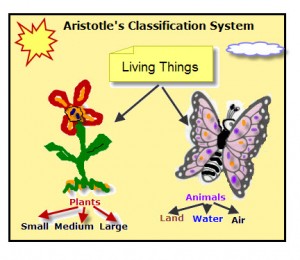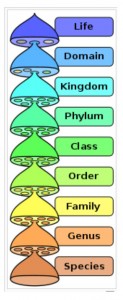What is Taxonomy and Who Introduced It?

Taxonomy is the science of how living things are grouped together. Another name often used for taxonomy is classification.
Scientists who study taxonomy are called taxonomists. The Greek scientist, Aristotle (384-322 B.C.), was one of the first scientist to organize living things, thus among other things he studied, Aristotle was a taxonomist.
Aristotle developed the first classification system, which divided all known organisms into two groups:
PLANTS and ANIMALS
Aristotle then divided each of these main groups into three smaller groups.
Animal Subgroups: Land, Water, Air
Plant Subgroups: Small, Medium, Large
Aristotle’s classification system was not very good. There were too many organisms that didn’t fit. For example, frogs are born in water and have gills like fish, but when they grow up they have lungs and can live on land. So how would Aristotle classify frogs? In Aristotle’s classification system, birds, bats, and flying insects were grouped together even though they have little in common except they can fly. But the penguin is a bird that cannot fly. So Aristotle would not have classified them as birds.
Even with the many problems of Aristotle’s limited classification system, it was used for nearly 2000 years until it was replaced in the 1700s by the Swedish biologist, Carolus Linnaeus (1707-1778).
Linnaeus, like Aristotle, classified organisms according to their traits. The classification systems of both Aristotle and Linnaeus started with the same two groups: Plants and Animals. Linnaeus called these groups, kingdoms. But, unlike Aristotle, Linnaeus divided kingdom into five levels: class, order, genus, species, and variety. Organisms were placed in these levels based on traits, including similarities of body parts , physical form such as size, shape, and methods of getting food.
Linnaeus is known as the father of taxonomy. In addition to his expanding the classification system, he established a simple way of naming each species. This is called a binomial naming system and it has two parts. The first part of the species name identifies the genus to which the species belongs; the second part identifies the species within the genus.
For example, humans belong to the genus Homo and within this genus to the species sapiens, thus the two-part species name for humans is Homo sapiens. The genus name is capitalized and each name is written in italics.
Ecology For Every Kid
This book has information and experiments about ecology.
Ecology is the study of the behavior of living things in their natural surroundings and how they affect each other.
(Paid Link)

